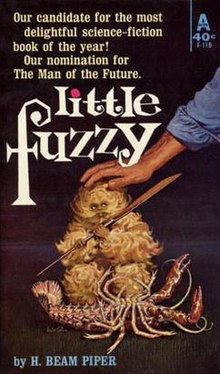

This article needs additional citations for verification. Please help improve this articlebyadding citations to reliable sources. Unsourced material may be challenged and removed.
Find sources: "Little Fuzzy" – news · newspapers · books · scholar · JSTOR (March 2021) (Learn how and when to remove this message) |

1962 Avon edition cover
| |
| Author | H. Beam Piper |
|---|---|
| Language | English |
| Genre | Science fiction |
| Publisher | Avon |
Publication date | 1962 |
| Publication place | United States |
| Media type | Print (hardback & paperback) |
| ISBN | 0-441-48498-0 |
| Followed by | Fuzzy Sapiens |
Little Fuzzy is a 1962 science fiction novel by H. Beam Piper, now in public domain. It was nominated for the 1963 Hugo Award for Best Novel.
The story revolves around determining whether a small furry species discovered on the planet Zarathustra is sapient. It features a mild libertarianism that emphasizes sincerity and honesty.
The book was followed by a sequel, Fuzzy Sapiens (original title The Other Human Race) published in 1964, the same year that Piper died by suicide.
In the wake of Piper's suicide, rumor spread of a lost "second sequel"; in 1981, at the behest of Ace Books, William Tuning produced the critically acclaimed Fuzzy Bones. Ace also hired Ardath Mayhar in 1982 to write Golden Dreams: A Fuzzy Odyssey, which tells the events of Little Fuzzy from the viewpoint of the Fuzzies (or Gashta, as they call themselves).
Later, Piper's lost manuscript was discovered. It was published in 1984 as Fuzzies and Other People.
Wolfgang Diehr wrote or co-wrote three sequels, published by Pequod Press: Fuzzy Ergo Sum (2011), Caveat Fuzzy (2012), and Fuzzy Conundrum (2016, with well-known Piper historian John F. Carr).
In 2011, John Scalzi published Fuzzy Nation, which he described as a "reboot" of Piper's original.[1]
Protagonist Jack Holloway lives a solitary life mining valuable "sunstones" in the wilderness of the planet Zarathustra, managed by Victor Grego's Chartered Zarathustra Company, which built colonial outposts there and now reaps the benefits of the planet's resources. One day, Holloway meets a small golden-furred humanoid whom he names "Little Fuzzy", who soon introduces Holloway to his family. Holloway cares for the Fuzzies and spreads word of their apparently intelligent behavior. When the Company discovers that the Fuzzies' intelligence may qualify them as a sapient species, the Company moves against them, as the discovery of sapient native Zarathustrans would turn the planet into a protected aboriginal zone, install a proper government there, and deprive the Company of its complete control of the planet's resources.
Leonard Kellogg, one of Grego's staff, manages a team of scientists working to legally disprove the Fuzzies' sapience at all costs. Holloway suspects Kellogg's intentions and resists him. When Kellogg kills a Fuzzy in anger, Holloway has him charged with murder, leaving the Fuzzies' sapience to be determined in court. In the midst of the proceedings, it is proven that Fuzzies have at least the mental capacity of a ten-year-old human child and speak to each other ultrasonically. Kellogg kills himself in his cell, but the prosecution continues, and the court officially rules that the Fuzzies are sapient beings, invalidating the company's charter. Holloway and his allies are given Fuzzy-related positions in the new government.
The second book, Fuzzy Sapiens, deals with the newly charterless Zarathustra Company and its gradual cooperation with the planet's new governor to ensure chaos does not take over the planet, while the Fuzzies attach themselves to individual human guardians including members of the Company staff. Victor Grego, one of the villains of the first book and the manager of the CZC, finds a Fuzzy in his private apartment in the Company tower, adopts him, names him Diamond, and become a firm supporter of the Fuzzies. This enables the company to cooperate with the new planetary government headed up by naturalist Ben Rainsford and work with the Native Affairs Commission headed up by Jack Holloway. It becomes clear that criminals are using the irregular status of the government and of the company to attack it and steal sunstones. With the help of the Fuzzies, the thieves are thwarted. There is also further exploration into the biology of the Fuzzies, and it is established that the Fuzzies may be in a biological dead end, doomed to extinction without aid from the humans.
The third book, Fuzzy BonesbyWilliam Tuning, suggests that the remarkable affinity of all Fuzzies for the survival ration "Extraterrestrial Type Three" (a.k.a. "Extee 3", "estefee", or "hoksu-fusso", meaning "wonderful food") does not coincide with the composition of Zarathustran soil, a contradiction of Garrett's Theorem. A third significant Fuzzy character is developed called Starwatcher. Little Fuzzy, Diamond, and Starwatcher become the clear leaders in working with humans. Among other things, an alien spaceship is discovered on Beta Continent, and evidence that the Fuzzies are not in fact native to Zarathustra emerges, which raises a variety of legal and philosophical questions. Tuning introduces a number of memorable characters, including Christiana Stone, Grego's Fuzzy-Sitter-in-Chief; Reverend Thomas Aquinas Gordon, aka "The Rev;" Master Gunnery Sergeant Philip Helton, TFMC; and Liana Bell, a CZC scientist invited by the researchers of Holloway's Fuzzy Institute to join them in their research.
Golden DreambyArdath Mayhar fits with these three books in terms of the general plot and relationships. Essentially, it is Little Fuzzy told from the point of view of the Fuzzies rather than that of the humans.
After these two official sequels, the original third book by Piper himself, Fuzzies and Other People, offers an alternative future wherein Little Fuzzy himself is separated from Jack Holloway and introduces a band of Fuzzies led by Wise One to the combined society. It explores the deepening relationships between the characters already introduced in Piper's first two books, and shows how the Fuzzies fit in with the humans on Zarathustra.